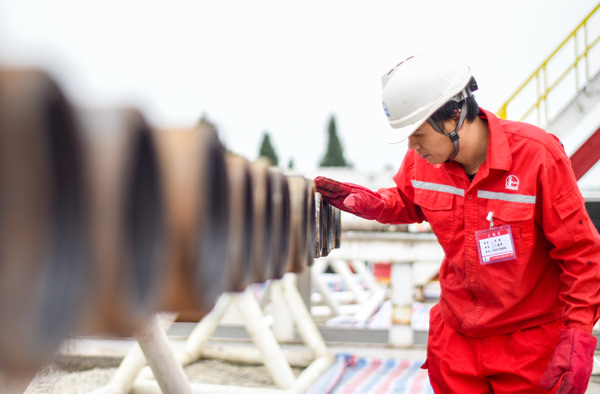Sinopec full steam ahead with shale gas revolution
 |
|
A worker checks facilities at a shale gas field in Fuling, Chongqing. [Photo/Xinhua] |
China Petroleum and Chemical Corp, the world's largest refiner, has vowed to double its annual natural gas output by 2020 to reach 40 billion cubic meters.
The company, also known as Sinopec, said its Fuling shale gas field, China's first shale gas commercial production program launched in 2014, will reach an annual output of up to 10 billion cu m by the end of this year.
Proven geological reserves of shale gas at Fuling have exceeded 600 billion cu m, after the discovery of more than 220 billion cu m in additional deposits this month.
Sinopec's natural gas output increased 4.3 percent year-on-year in 2016, and it has pledged to further develop its resources in Sichuan as well as in Erdos in the Inner Mongolia autonomous region.
Analysts said Sinopec's efforts are in accordance with China's ambitious goal to wean itself off coal, betting big on a shale gas boom to decrease its dependency on coal and foreign gas imports.
Wang Lu, an Asia-Pacific oil and gas analyst at Bloomberg Intelligence, said China's aggressive shale gas development target may boost the share of gas in its energy mix.
"Sinopec's Fuling project will play a leading role in achieving China's goal of producing 80 to 100 billion cu m in 2030," she said.
"Its shale gas production may contribute about 4 to 5 percent of China's total gas consumption by 2020, and Sinopec can also strengthen its upstream unit, which is weaker than its domestic competitors PetroChina and CNOOC, by developing shale gas."
According to S&P Global Platts, a provider of energy and commodities information, China's liquefied natural gas imports in the first five months in 2017 surged 38 percent year-on-year to 12.88 million metric tons, as pollution concerns spurred greater gas usage.
The Chinese government announced in its 13th Five-Year Plan (2016-20) for natural gas that it is keen to promote gas usage in the country and plans to raise the proportion of natural gas in the energy consumption mix to around 10 percent by 2020 from around 5.9 percent in 2015.
Natural gas imports will play an increasingly important role in the country's energy mix, especially for coastal regions which are far from pipelines and domestic gas fields, it said.
Wang said China's shale gas resources could be as much as 21.8 trillion cu m, but technological and geological challenges may slow the development of the unconventional gas.
In addition, lowered shale-gas subsidies may also discourage developers, while ample supply from domestic conventional gas, LNG, pipeline imports, and cheap oil might also impede shale gas development, she said.
Li Li, energy research director at ICIS China, a consulting company that provides analysis of China's energy market, said the technological challenge is one of the most significant factors dampening China's shale gas exploration.
Li said despite being the third country that has successfully commercialized shale gas and the sector might become a growing factor, China is currently far inferior to the US in shale gas commercialization mostly due to technological challenges.
Chances are low that China becomes the next shale gas superpower in the near future, and the cooling of the enthusiasm that foreign companies had for Chinese shale gas might also hamper the development, as expertise to access the immense shale deposits is also necessary, she said.
Foreign investors have been pulling back from Chinese shale gas exploration in recent years, including ConocoPhillips of the US, which has quit shale gas exploration in China after abandoning a second block in the Sichuan basin earlier this year, considering the block did not meet its benchmark for commercial development.
"We need the technology and the knowhow to diversify and reduce risks by working with these companies on complicated projects", she said.
However, considering the natural gas price is likely to witness a surge in the future and given Sinopec's dedication to increase shale gas output and reduce costs, the future is promising, she added.
According to the oil and gas reserve assessment office under the Ministry of Land and Resources, against the backdrop of low oil prices, China has come up with the core technologies for the exploration and development of the shale gas, while achieving the localization of key equipment.
China has also set more than 100 technical standards and substantially reduced the cost of shale gas exploration in Fuling.
According to Sinopec, after years of development, most of the key equipment for shale gas exploration has been domestically manufactured, including the drilling wells, and the testing, extraction and transportation facilities.




















